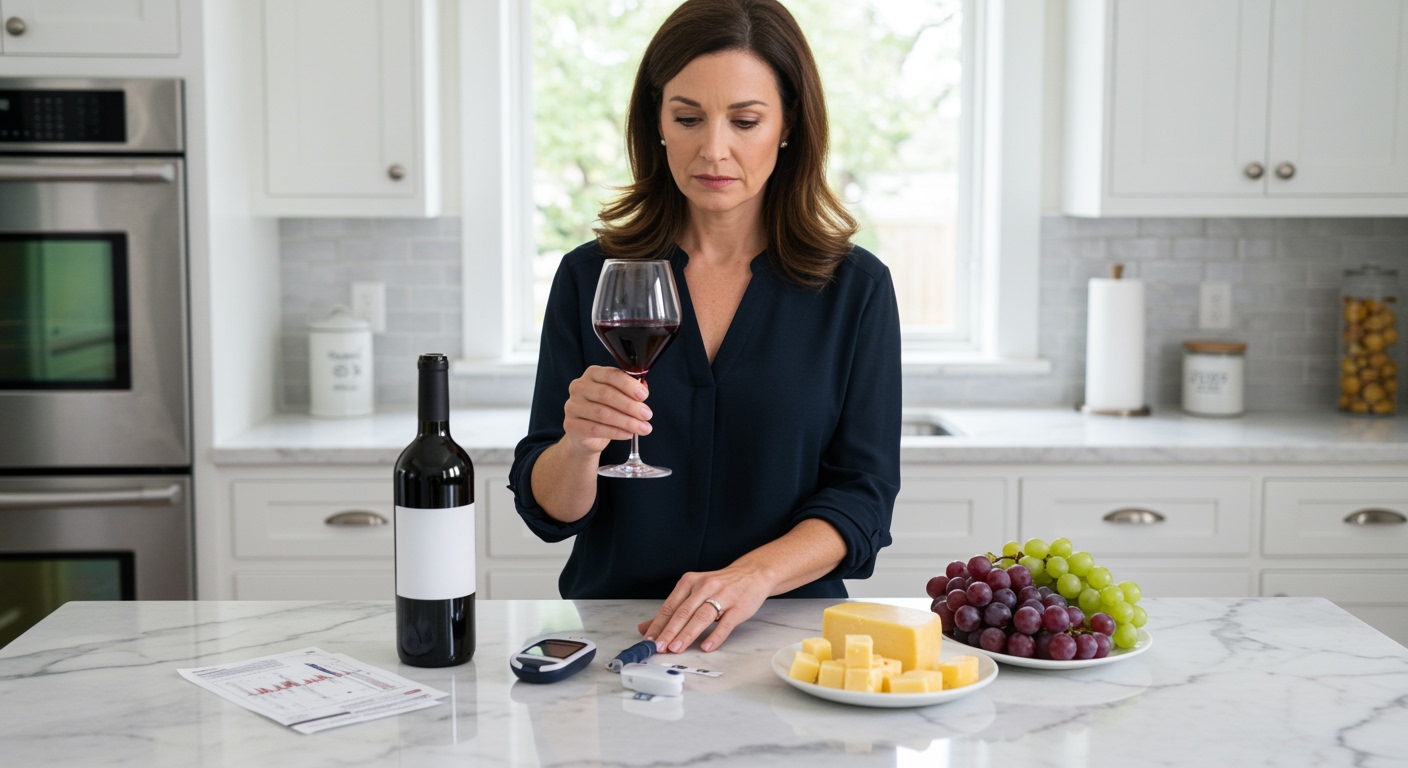✪ Key Takeaway: Wine can be consumed safely by people with diabetes in moderation, but requires careful blood sugar monitoring and timing.
Introduction
You pour yourself a glass of wine after a long day, then pause with worry about your blood sugar.
Many people with diabetes wonder if they can safely enjoy wine without causing dangerous blood sugar swings or complications.
Hi, I’m Abdur, your nutrition coach and today I’m going to explain exactly how wine affects your blood sugar and share the safest ways to enjoy it.
How Does Wine Affect Blood Sugar Levels?
Wine creates a complex response in your body that differs from other alcoholic beverages.
When you drink wine, the alcohol initially causes your blood sugar to drop because it blocks your liver from releasing stored glucose.
Your liver normally releases glucose between meals to keep your blood sugar stable.
However, wine also contains natural sugars from grapes that can raise your blood sugar initially.
Red wine typically contains 1-2 grams of sugar per glass, while sweet wines can contain much more.
The alcohol effect usually dominates and can cause delayed low blood sugar hours after drinking, especially if you take insulin or certain diabetes medications.
This delayed reaction makes wine particularly tricky because the hypoglycemia can occur while you sleep.
✪ Pro Tip: Always eat food containing carbohydrates when drinking wine to prevent dangerous blood sugar drops.
What Are The Benefits Of Wine For Diabetes?
Research shows that moderate wine consumption may offer some benefits for people with diabetes.
Red wine contains antioxidants called polyphenols, particularly resveratrol, which may improve insulin sensitivity.
Studies suggest that people who drink wine with meals have a lower risk of developing type 2 diabetes compared to non-drinkers.
The Mediterranean diet, which includes moderate wine consumption, is associated with better blood sugar control and reduced diabetes complications.
Wine may also help reduce inflammation in your body, which plays a role in diabetes progression.
However, these benefits only apply to moderate consumption and disappear completely with heavy drinking.
The key word here is moderation, which means no more than one drink per day for women and two for men.
✪ Fact: Red wine contains more antioxidants than white wine due to longer contact with grape skins during production.
What Are The Risks Of Wine With Diabetes?
Wine poses several serious risks for people with diabetes that you must understand.
The biggest danger is delayed hypoglycemia, which can occur 8-12 hours after drinking and may be life-threatening.
Wine can mask the warning signs of low blood sugar, making it harder to recognize when you need treatment.
If you take insulin or medications like sulfonylureas, wine significantly increases your risk of dangerous blood sugar drops.
Wine also contains calories that can contribute to weight gain if not accounted for in your meal plan.
Each glass of wine contains about 120-150 calories, mostly from alcohol and sugar.
Regular wine consumption can worsen diabetic complications like nerve damage, kidney disease, and eye problems if blood sugar control suffers.
✪ Note: Never drink wine on an empty stomach as this dramatically increases your risk of severe hypoglycemia.
How Should You Drink Wine Safely With Diabetes?
Safe wine consumption with diabetes requires careful planning and strict adherence to guidelines.
Always drink wine with a meal that contains carbohydrates to help prevent blood sugar drops.
Check your blood sugar before drinking and monitor it more frequently for the next 12-24 hours.
Limit yourself to one glass per day if you are a woman or two glasses if you are a man.
Choose dry wines over sweet wines because they contain less sugar and cause smaller blood sugar spikes.
Never use wine to treat low blood sugar because the alcohol will prevent recovery and make hypoglycemia worse.
Talk to your doctor before drinking wine, especially if you take diabetes medications or have complications.
✪ Pro Tip: Keep glucose tablets nearby when drinking wine in case you need to treat unexpected low blood sugar.
Which Type Of Wine Is Best For Diabetes?
Not all wines are created equal when it comes to blood sugar impact.
Dry red wines like Cabernet Sauvignon, Merlot, and Pinot Noir contain the least sugar and most antioxidants.
These wines typically contain less than 2 grams of sugar per glass and provide the most health benefits.
Dry white wines like Sauvignon Blanc and Pinot Grigio are also good choices with low sugar content.
Avoid sweet wines, dessert wines, and fortified wines because they contain high amounts of sugar that will spike your blood glucose.
Champagne and other dry sparkling wines are acceptable options because they contain minimal residual sugar.
Always check the label for sugar content or ask your server about the sweetness level before ordering.
✪ Fact: Dry wines contain less than 10 grams of sugar per liter, while sweet wines can contain over 45 grams per liter.
The Bottom Line
Wine can be part of a healthy lifestyle for people with diabetes when consumed responsibly and in moderation.
Health is not about perfection but about making informed choices that support your long-term wellbeing.
I would love to hear about your experiences with wine and diabetes management, so please share your thoughts or questions in the comments below.
References
At NutritionCrown, we use quality and credible sources to ensure our content is accurate and trustworthy. Below are the sources referenced in creating this article:
- PMC: Alcohol consumption and risk of type 2 diabetes
- Diabetes Journals: Red Wine and Diabetes Health
- Healthline: Red Wine and Type 2 Diabetes
- American Heart Association: Wine with meals may lower type 2 diabetes risk





